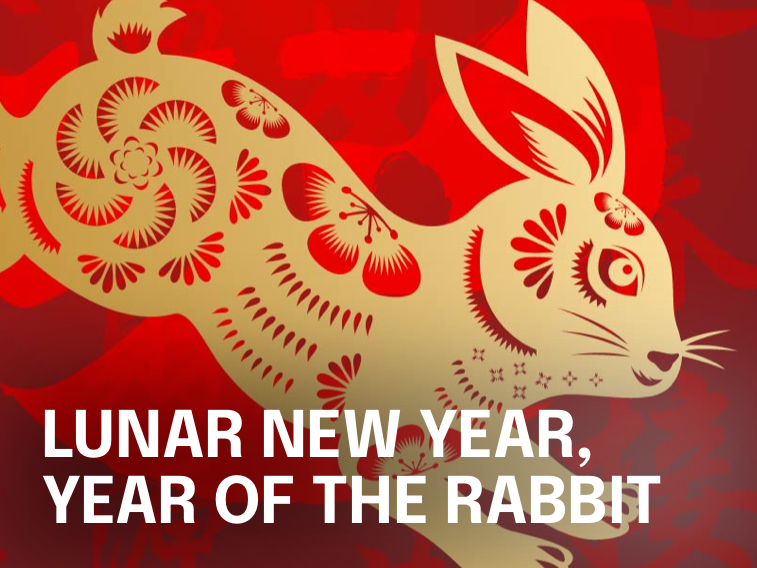Luxury property performance in the spotlight in our annual review as trophy homes continue to set new records


Article
Global growth is expected to slow this year, but there are paths opening as we enter the new Lunar Year that could lead to a brighter picture, with a bit of luck in the Year of the Rabbit.

Luck is something that has been largely absent from the global economy in recent years, so it may provide some comfort that as we enter the new Lunar New Year we are in the Year of the Rabbit – an animal in the Chinese zodiac associated with luck and good fortune.
Why is that important? Because with a bit of luck, the year ahead has the potential to be significantly brighter than many currently expect.
Economies around the world are reopening up after the worst of the COVID-19 pandemic, but we are still fighting the economic consequences of the pandemic. Fragility in supply chains has seen inflation rise to multi-decade highs and central banks have rapidly raised rates in response.
This rapid tightening in financial conditions is set to see global economic growth slow considerably in 2023 – down to around 2.3%, compared with a long-term average of 3.4% (between 1980 and 2021). Excluding the extreme shocks of the Global Financial Crisis and the initial wave of COVID-19, this would represent the weakest rate of growth since 1993.
This downturn has been exacerbated by the flow on effects from Russia’s invasion of Ukraine, which has negatively impacted energy markets (most notably in Europe) as well agricultural supplies.
The glass half full perspective
Faced with a somewhat gloomy outlook, what could go well in the Year of the Rabbit and give us some upside risk to our forecasts?
The biggest factor could be China successfully navigating its way out from the zero-COVID policy. Unlike most advanced economies and its East Asian peers, China remained an outlier in terms of public health policies around COVID-19 for the bulk of 2022 – reflecting fears around the efficacy of domestically produced vaccines, the low vaccination rates among the elderly, the comparative weak healthcare system (particularly outside the major cities) and the greater transmissibility of recent variants (such as Omicron). Large scale lockdowns and a lack of financial support for households has meant that domestic consumption in China has been extremely weak, with recent growth heavily reliant on infrastructure investment and goods exports.
However, Chinese authorities pivoted in early December, relaxing quarantine measures (allowing asymptomatic and mild cases to isolate at home), reducing widespread, high frequency PCR testing, ending closed loop requirements for industry (which forced workers to sleep onsite at factories) and eliminating proof of negative tests to enter public spaces. Public messaging around COVID-19 by health officials has also shifted, noting the reduced severity of the Omicron variant (compared with earlier strains).
Experience from other countries has shown that infections tend to increase as COVID-19 restrictions are reduced. Key factors to watch for China’s economy are how its health system copes with the likely increase in hospitalisations, and how residents respond to a wider spread of the virus (with the potential for weak activity due to self-isolation – something that anecdotally appears to be happening in Beijing at present). While there is little doubt that the zero-COVID policies have constrained China’s economy in recent times, the potential for a disruptive period as case numbers increase means that there will not necessarily be an immediate bounce in activity. Indeed, the massive movement of people across the country during the Lunar New Year period means that it could be a point at which COVID-19 spreads widely.
Still, in the medium term the move away from zero-COVID should provide households and private businesses with greater confidence about the future – supporting a recovery in consumption and private investment that would boost China’s domestic economy. The reopening of international borders would allow Chinese tourists to return around the globe. These factors would present much stronger opportunities for Australian businesses that target these segments.
Can Australia and China be friends again?
From an Australian perspective, an improvement in the diplomatic relationship with China would also be a major positive. Relations between the two countries started to deteriorate prior to the pandemic, but worsened during it, leading to a range of official and unofficial trade measures imposed on Australian exports to China. A recent meeting between Prime Minister Albanese and President Xi Jinping may be the first step in repairing terms with our major trading partner.
Is a global recession a fait-accompli?
Outside China, the rapid tightening in monetary policy in 2022 and early 2023 is expected to drive the United States, the Euro-zone and United Kingdom into recession. However, on average, households in these regions were able to build up sizeable savings during the pandemic and unemployment has remained low, which has provided support for consumption despite the strength of inflation and could keep growth ticking over in 2023 (particularly if recent falls in oil prices are sustained), so recessions are not a foregone conclusion.
Lower energy prices generally could be an outcome if there is a rapid and reasonable resolution to the Russia-Ukraine conflict. Such an outcome, allied to a successful reopening in China, could see a major easing in the supply chain constraints that have been a key driver of inflation that has risen to multi-decade highs. Should inflation fall rapidly – back to usual target ranges or below – this could result in major global central banks starting to cut their policy rates faster than currently anticipated.
How will Australia fare?
The outlook for Australia mirrors that of most other advanced economies – with elevated inflation and tightening monetary policy set to slow consumption next year, likely seeing GDP growth below 1% for 2023 and 2024. However, the low rate of unemployment and accumulated savings are likely to continue to provide something of a buffer for households. Elevated commodity prices are also providing a temporary boost to Australia’s national income, and migration is rapidly rebounding. A recovery in China’s economy and improving trade relationship would add an additional source of support.
Indeed, with a little luck, the Year of the Rabbit might see the Australian economy weather another challenging period without substantial damage.
The information contained in this article is gathered from multiple sources believed to be reliable as of the end of December 2022 and is intended to be of a general nature only. It has been prepared without taking into account any person’s objectives, financial situation or needs. JBWere Limited ABN 68 137 978 360 AFSL 341162 (JBWere) is a wholly owned subsidiary of National Australia Bank Limited ABN 12 004 044 937 AFSL and Australian Credit Licence 230686 (NAB). Before acting on this information, NAB and JBWere recommend that you consider whether it is appropriate for your circumstances. NAB and JBWere recommend that you seek independent legal, financial and taxation advice before acting on any information in this article.
© National Australia Bank Limited. ABN 12 004 044 937 AFSL and Australian Credit Licence 230686.